Noboru Harada
Description and Discussion on DCASE 2025 Challenge Task 4: Spatial Semantic Segmentation of Sound Scenes
Jun 12, 2025Abstract:Spatial Semantic Segmentation of Sound Scenes (S5) aims to enhance technologies for sound event detection and separation from multi-channel input signals that mix multiple sound events with spatial information. This is a fundamental basis of immersive communication. The ultimate goal is to separate sound event signals with 6 Degrees of Freedom (6DoF) information into dry sound object signals and metadata about the object type (sound event class) and representing spatial information, including direction. However, because several existing challenge tasks already provide some of the subset functions, this task for this year focuses on detecting and separating sound events from multi-channel spatial input signals. This paper outlines the S5 task setting of the Detection and Classification of Acoustic Scenes and Events (DCASE) 2025 Challenge Task 4 and the DCASE2025 Task 4 Dataset, newly recorded and curated for this task. We also report experimental results for an S5 system trained and evaluated on this dataset. The full version of this paper will be published after the challenge results are made public.
Towards Pre-training an Effective Respiratory Audio Foundation Model
May 21, 2025Abstract:Recent advancements in foundation models have sparked interest in respiratory audio foundation models. However, the effectiveness of applying conventional pre-training schemes to datasets that are small-sized and lack diversity has not been sufficiently verified. This study aims to explore better pre-training practices for respiratory sounds by comparing numerous pre-trained audio models. Our investigation reveals that models pre-trained on AudioSet, a general audio dataset, are more effective than the models specifically pre-trained on respiratory sounds. Moreover, combining AudioSet and respiratory sound datasets for further pre-training enhances performance, and preserving the frequency-wise information when aggregating features is vital. Along with more insights found in the experiments, we establish a new state-of-the-art for the OPERA benchmark, contributing to advancing respiratory audio foundation models. Our code is available online at https://github.com/nttcslab/eval-audio-repr/tree/main/plugin/OPERA.
Assessing the Utility of Audio Foundation Models for Heart and Respiratory Sound Analysis
Apr 25, 2025



Abstract:Pre-trained deep learning models, known as foundation models, have become essential building blocks in machine learning domains such as natural language processing and image domains. This trend has extended to respiratory and heart sound models, which have demonstrated effectiveness as off-the-shelf feature extractors. However, their evaluation benchmarking has been limited, resulting in incompatibility with state-of-the-art (SOTA) performance, thus hindering proof of their effectiveness. This study investigates the practical effectiveness of off-the-shelf audio foundation models by comparing their performance across four respiratory and heart sound tasks with SOTA fine-tuning results. Experiments show that models struggled on two tasks with noisy data but achieved SOTA performance on the other tasks with clean data. Moreover, general-purpose audio models outperformed a respiratory sound model, highlighting their broader applicability. With gained insights and the released code, we contribute to future research on developing and leveraging foundation models for respiratory and heart sounds.
Baseline Systems and Evaluation Metrics for Spatial Semantic Segmentation of Sound Scenes
Mar 28, 2025Abstract:Immersive communication has made significant advancements, especially with the release of the codec for Immersive Voice and Audio Services. Aiming at its further realization, the DCASE 2025 Challenge has recently introduced a task for spatial semantic segmentation of sound scenes (S5), which focuses on detecting and separating sound events in spatial sound scenes. In this paper, we explore methods for addressing the S5 task. Specifically, we present baseline S5 systems that combine audio tagging (AT) and label-queried source separation (LSS) models. We investigate two LSS approaches based on the ResUNet architecture: a) extracting a single source for each detected event and b) querying multiple sources concurrently. Since each separated source in S5 is identified by its sound event class label, we propose new class-aware metrics to evaluate both the sound sources and labels simultaneously. Experimental results on first-order ambisonics spatial audio demonstrate the effectiveness of the proposed systems and confirm the efficacy of the metrics.
M2D2: Exploring General-purpose Audio-Language Representations Beyond CLAP
Mar 28, 2025Abstract:Contrastive language-audio pre-training (CLAP) has addressed audio-language tasks such as audio-text retrieval by aligning audio and text in a common feature space. While CLAP addresses general audio-language tasks, its audio features do not generalize well in audio tasks. In contrast, self-supervised learning (SSL) models learn general-purpose audio features that perform well in diverse audio tasks. We pursue representation learning that can be widely used in audio applications and hypothesize that a method that learns both general audio features and CLAP features should achieve our goal, which we call a general-purpose audio-language representation. To implement our hypothesis, we propose M2D2, a second-generation masked modeling duo (M2D) that combines an SSL M2D and CLAP. M2D2 learns two types of features using two modalities (audio and text) in a two-stage training process. It also utilizes advanced LLM-based sentence embeddings in CLAP training for powerful semantic supervision. In the first stage, M2D2 learns generalizable audio features from M2D and CLAP, where CLAP aligns the features with the fine LLM-based semantic embeddings. In the second stage, it learns CLAP features using the audio features learned from the LLM-based embeddings. Through these pre-training stages, M2D2 should enhance generalizability and performance in its audio and CLAP features. Experiments validated that M2D2 achieves effective general-purpose audio-language representation, highlighted with SOTA fine-tuning mAP of 49.0 for AudioSet, SOTA performance in music tasks, and top-level performance in audio-language tasks.
SoundSil-DS: Deep Denoising and Segmentation of Sound-field Images with Silhouettes
Nov 12, 2024Abstract:Development of optical technology has enabled imaging of two-dimensional (2D) sound fields. This acousto-optic sensing enables understanding of the interaction between sound and objects such as reflection and diffraction. Moreover, it is expected to be used an advanced measurement technology for sonars in self-driving vehicles and assistive robots. However, the low sound-pressure sensitivity of the acousto-optic sensing results in high intensity of noise on images. Therefore, denoising is an essential task to visualize and analyze the sound fields. In addition to denoising, segmentation of sound and object silhouette is also required to analyze interactions between them. In this paper, we propose sound-field-images-with-object-silhouette denoising and segmentation (SoundSil-DS) that jointly perform denoising and segmentation for sound fields and object silhouettes on a visualized image. We developed a new model based on the current state-of-the-art denoising network. We also created a dataset to train and evaluate the proposed method through acoustic simulation. The proposed method was evaluated using both simulated and measured data. We confirmed that our method can applied to experimentally measured data. These results suggest that the proposed method may improve the post-processing for sound fields, such as physical model-based three-dimensional reconstruction since it can remove unwanted noise and separate sound fields and other object silhouettes. Our code is available at https://github.com/nttcslab/soundsil-ds.
Description and Discussion on DCASE 2024 Challenge Task 2: First-Shot Unsupervised Anomalous Sound Detection for Machine Condition Monitoring
Jun 11, 2024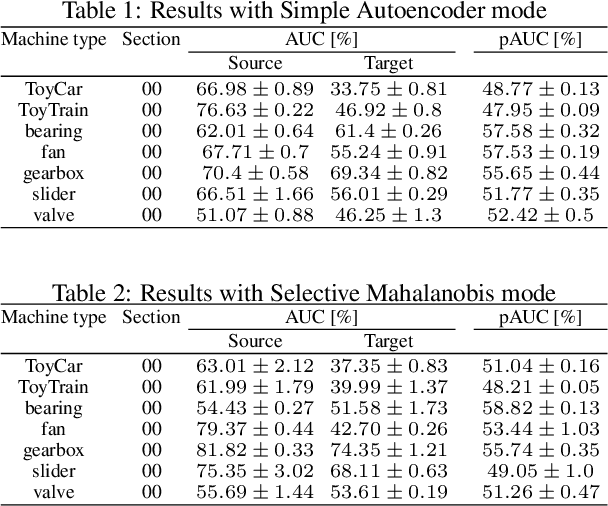
Abstract:We present the task description of the Detection and Classification of Acoustic Scenes and Events (DCASE) 2024 Challenge Task 2: First-shot unsupervised anomalous sound detection (ASD) for machine condition monitoring. Continuing from last year's DCASE 2023 Challenge Task 2, we organize the task as a first-shot problem under domain generalization required settings. The main goal of the first-shot problem is to enable rapid deployment of ASD systems for new kinds of machines without the need for machine-specific hyperparameter tunings. This problem setting was realized by (1) giving only one section for each machine type and (2) having completely different machine types for the development and evaluation datasets. For the DCASE 2024 Challenge Task 2, data of completely new machine types were newly collected and provided as the evaluation dataset. In addition, attribute information such as the machine operation conditions were concealed for several machine types to mimic situations where such information are unavailable. We will add challenge results and analysis of the submissions after the challenge submission deadline.
M2D-CLAP: Masked Modeling Duo Meets CLAP for Learning General-purpose Audio-Language Representation
Jun 04, 2024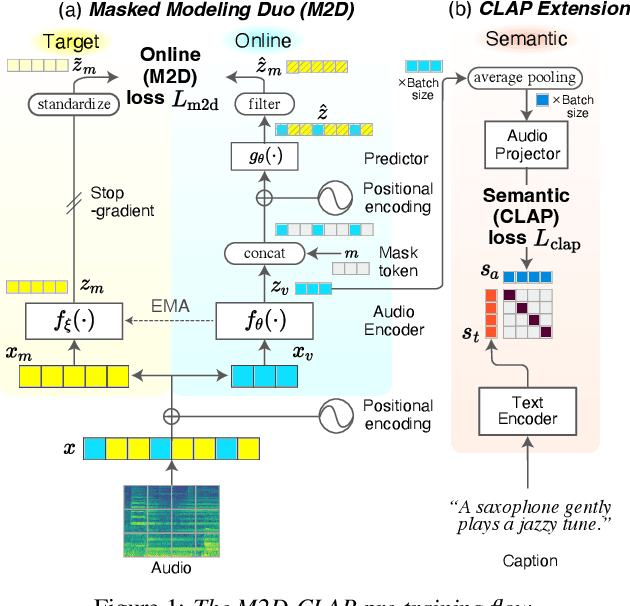



Abstract:Contrastive language-audio pre-training (CLAP) enables zero-shot (ZS) inference of audio and exhibits promising performance in several classification tasks. However, conventional audio representations are still crucial for many tasks where ZS is not applicable (e.g., regression problems). Here, we explore a new representation, a general-purpose audio-language representation, that performs well in both ZS and transfer learning. To do so, we propose a new method, M2D-CLAP, which combines self-supervised learning Masked Modeling Duo (M2D) and CLAP. M2D learns an effective representation to model audio signals, and CLAP aligns the representation with text embedding. As a result, M2D-CLAP learns a versatile representation that allows for both ZS and transfer learning. Experiments show that M2D-CLAP performs well on linear evaluation, fine-tuning, and ZS classification with a GTZAN state-of-the-art of 75.17%, thus achieving a general-purpose audio-language representation.
Exploring Pre-trained General-purpose Audio Representations for Heart Murmur Detection
Apr 26, 2024
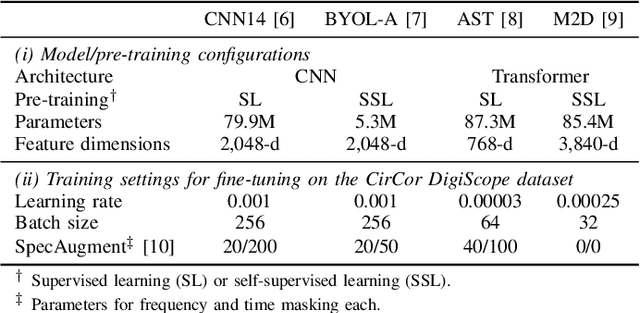
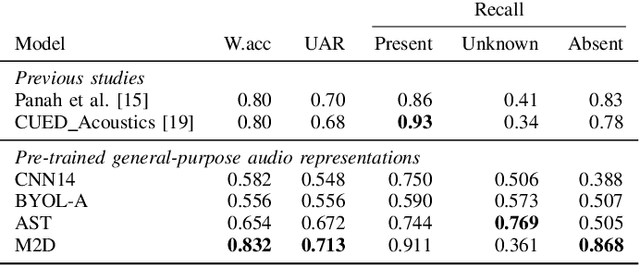

Abstract:To reduce the need for skilled clinicians in heart sound interpretation, recent studies on automating cardiac auscultation have explored deep learning approaches. However, despite the demands for large data for deep learning, the size of the heart sound datasets is limited, and no pre-trained model is available. On the contrary, many pre-trained models for general audio tasks are available as general-purpose audio representations. This study explores the potential of general-purpose audio representations pre-trained on large-scale datasets for transfer learning in heart murmur detection. Experiments on the CirCor DigiScope heart sound dataset show that the recent self-supervised learning Masked Modeling Duo (M2D) outperforms previous methods with the results of a weighted accuracy of 0.832 and an unweighted average recall of 0.713. Experiments further confirm improved performance by ensembling M2D with other models. These results demonstrate the effectiveness of general-purpose audio representation in processing heart sounds and open the way for further applications. Our code is available online which runs on a 24 GB consumer GPU at https://github.com/nttcslab/m2d/tree/master/app/circor
Guided Masked Self-Distillation Modeling for Distributed Multimedia Sensor Event Analysis
Apr 12, 2024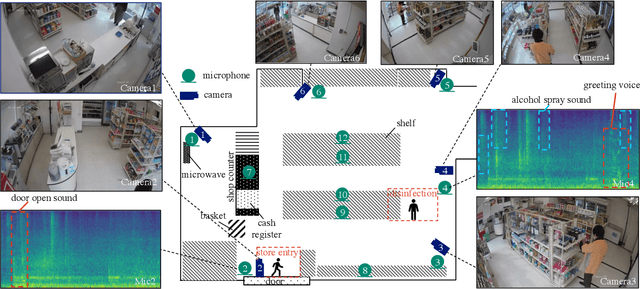
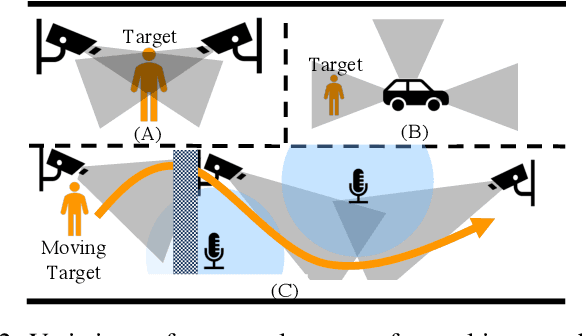
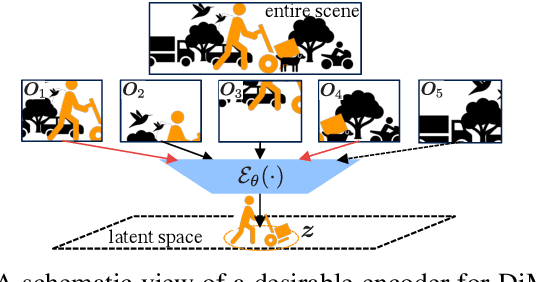

Abstract:Observations with distributed sensors are essential in analyzing a series of human and machine activities (referred to as 'events' in this paper) in complex and extensive real-world environments. This is because the information obtained from a single sensor is often missing or fragmented in such an environment; observations from multiple locations and modalities should be integrated to analyze events comprehensively. However, a learning method has yet to be established to extract joint representations that effectively combine such distributed observations. Therefore, we propose Guided Masked sELf-Distillation modeling (Guided-MELD) for inter-sensor relationship modeling. The basic idea of Guided-MELD is to learn to supplement the information from the masked sensor with information from other sensors needed to detect the event. Guided-MELD is expected to enable the system to effectively distill the fragmented or redundant target event information obtained by the sensors without being overly dependent on any specific sensors. To validate the effectiveness of the proposed method in novel tasks of distributed multimedia sensor event analysis, we recorded two new datasets that fit the problem setting: MM-Store and MM-Office. These datasets consist of human activities in a convenience store and an office, recorded using distributed cameras and microphones. Experimental results on these datasets show that the proposed Guided-MELD improves event tagging and detection performance and outperforms conventional inter-sensor relationship modeling methods. Furthermore, the proposed method performed robustly even when sensors were reduced.
 Add to Chrome
Add to Chrome Add to Firefox
Add to Firefox Add to Edge
Add to Edge